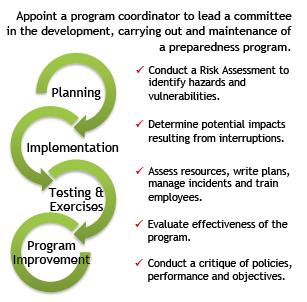A site emergency plan describes, in detail, an organization's policy and procedures for coping with an emergency situation on site. These policies and procedures should define how the organization will protect employees, visitors, contractors and anyone else at the business. Developing the plan is the process of assigning emergency related tasks to individuals in the organization and outlining protective actions to be taken. If you are specifically told to evacuate, shelter-in-place or seek medical treatment, do so immediately.
Review the Program

- Determine which staff, materials, procedures and equipment are absolutely necessary to keep the business operating.
- Review business process flow chart and include emergency payroll.
- Expedited financial decision-making and accounting systems to track and document costs in the event of a disaster.
- Establish procedures for succession of management; include at least one person not at the company headquarters.
- Decide who should participate in putting together an emergency plan. Consider a broad cross-section of people throughout the organization and focus on those with expertise vital to daily business functions.
- Identify key supplies, shippers, resources and other businesses you must interact with on a daily basis.
Make a Shelter-in-Place Plan
The following situations are examples of when it is best to stay where you are and avoid any uncertainty outside:
- Chemical Incident - How and where you take shelter is a matter of survival. "Seal the room" if air is badly contaminated with a chemical. Identify where you will go by choosing an interior room with few windows and doors if possible. Take emergency supply kit unless believed to be contaminated. Effectively close the business and bring everyone inside. Lock doors, close windows, air vents and fireplace dampers. Turn off fans, air conditioning and forced air heating systems. Seal all windows, doors and air vents with plastic sheeting and duct tape (measure the sheeting and cut in advance).
- Tornado Warning - Storm cellars or basements provide the best protection. If underground shelters are unavailable go to interior room or hallway on the lowest floor. Stay away from windows, corners, doors, and outside walls.
Make an Evacuation Plan
- Create a chain of command so that others are authorized to act in case your designated person is not available.
- Post maps for quick reference by employees. Identify two ways out of the building from different locations throughout your facility.
- Establish a warning system including plans to communicate with people who are hearing impaired or have other disabilities and those who do not speak English.
- Designate an assembly site by picking one location near your facility and another in the general area farther away. Determine who is responsible for providing an "all clear" or return-to-work notification. Cooperate with local authorities. It is important to coordinate and practice with other tenants or businesses in the area to avoid confusion and potential gridlock.
- Test and exercise the plan to evaluate the effectiveness of your program. Train personnel clarifying roles and responsibilities. Reinforce knowledge of procedures, facilities, systems and equipment. Improve individual performance, coordination and communications. Evaluate policies, plans, procedures and acknowledge team member skills. Reveal weaknesses and resource gaps. Comply with local laws, codes and regulations. Gain recognition of the emergency management and business continuity program.
Fire Safety
Fire is the most common. Each year fires cause thousands of deaths, injuries and billions of dollars in damage. Have your office, plant or facility inspected for fire safety, compliance with fire codes and regulations. Install smoke alarms, detectors and fire extinguishers in appropriate locations. Put a process in place for alerting the fire department.
Flooding Incidents
Elevate equipment off the floor to avoid electrical hazards in the event of flooding.
Terrorism Incidents
Immediately report any threats by calling 9-1-1. Consider how people, products, supplies and other things get into and leave your building facility. Plan for mail safety against terrorist attacks and identify any suspicious objects within your work place.
